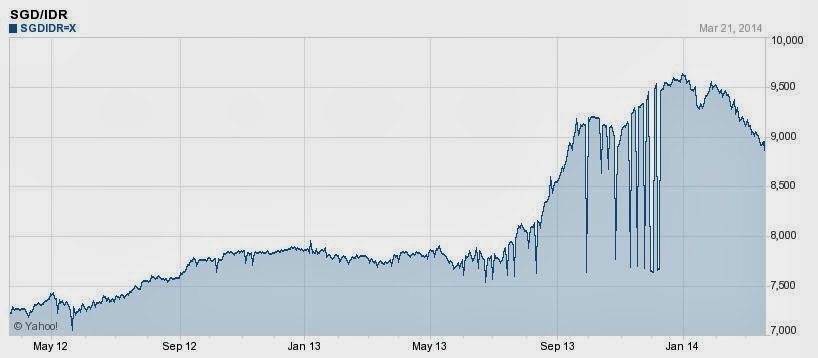I have 2 Indonesian REITs, both are owned and managed by the same owner, yet, their management of foreign exchange exposure could not have been more different.
The first REIT, Lippo Malls, collects rental income in Indonesian Rupiah (IDR) while holds debts in Singapore Dollar (SGD). Thus, when IDR falls against SGD, Lippo Malls' rental income and asset value in SGD drop while the debt value stays the same. This results in a sharp fall in both distribution per unit (DPU) to shareholders and net asset value (NAV). In 4Q2013, the quarterly DPU dropped from SGD0.0074 to SGD0.0056, a fall of 24.3%. The NAV fell from SGD0.56 to SGD0.41, a larger fall of 26.7%.
Figure 1 below shows the balance sheet of Lippo Malls as at end Dec 2013. Here, it clearly shows that property valuations as represented by Non-Current Assets fell from SGD1,756.5M to SGD1,415.7M while total debt went up from SGD472.5M to SGD622.5M (there was an additional debt of SGD150M during the same period).
 |
| Fig 1: Lippo Malls' Balance Sheet as at 31 Dec 2013 |
In contrast, First REIT pegs the rental income from its Indonesian properties to SGD and holds debts in SGD. Hence, when IDR falls against SGD, its rental income, asset value, DPU and NAV maintain their values. In 4Q2013, its quarterly DPU rose from SGD0.0172 to SGD0.0197, a rise of 14.5%. Its NAV rose from SGD0.83 to SGD0.97, a rise of 16.8%.
Why does Lippo Malls choose to hold its debts in SGD? The following 2 figures may shed some lights into its decision. Figures 2 and 3 below show the benchmark interest rates of Indonesia and Singapore respectively.
 |
| Fig 2: Indonesian Benchmark Interest Rate |
 |
| Fig 3: Singapore Benchmark Interest Rate |
From the 2 figures above, the Indonesian benchmark interest rate (prior to talks of tapering by the US Federal Reserves in May 2013) was about 5.75%. This is way above the Singapore benchmark interest rate of about 0.03% over the same period. Hence, by holding SGD denominated debts, Lippo Malls stands to save almost 5.72% in interest rate every year. There is a problem, however, which is IDR is constantly falling against SGD to compensate for the interest rate differential. When the fall is gradual, it usually does not pose any major problems. However, the fall in SGD/IDR forex rates after Aug 2013 was quite significant, as shown in the figure below.
 |
| Fig 4: SGD/IDR Foreign Exchange Rates |
Beginning in Aug 2013, the SGD/IDR fell from 7,800 to 9,600, a fall of 18.8% in a period of 4 months. SGD denominated debts thus became more expensive by 18.8%. The interest rate savings from holding SGD denominated debts is more than completely wiped out by fall in IDR forex rates.
Overall, does it make sense to hold foreign currency debts? Even before the current forex volatility, the Asian Financial Crisis way back in 1997 shows that it can cause a lot of harm in holding foreign currency debts. Lippo Malls apparently have not learnt the lessons of the Asian Financial Crisis.
See related blog posts:
See related blog posts:
"In contrast, First REIT pegs the rental income from its Indonesian properties to SGD and holds debts in SGD.". Do you mean debts in IDR instead.
ReplyDeleteNo, the debts are denominated in SGD.
DeleteRgds,
(The) Boring Investor